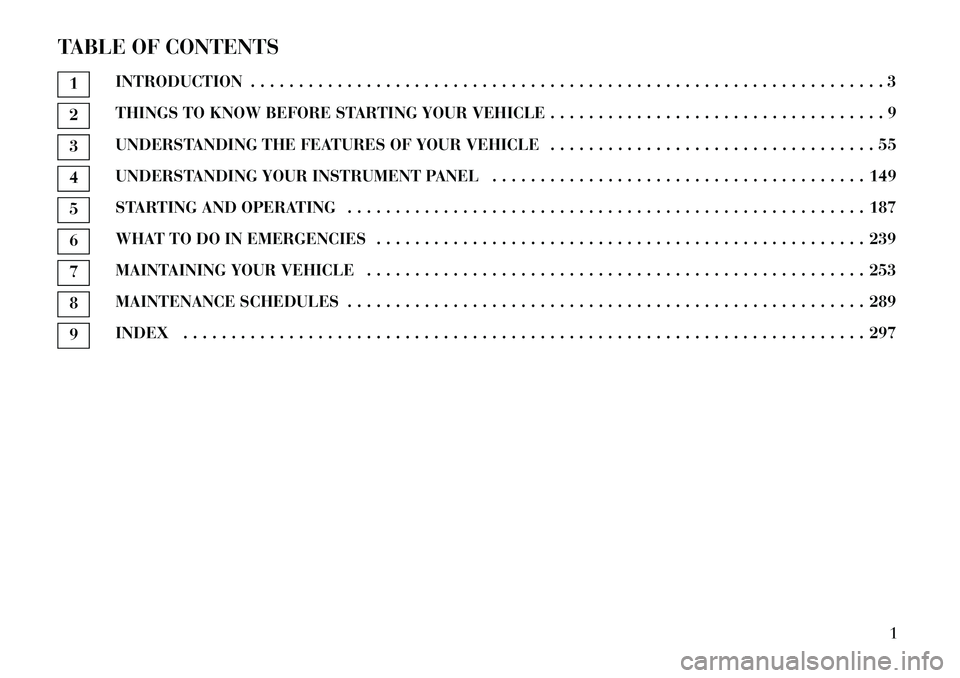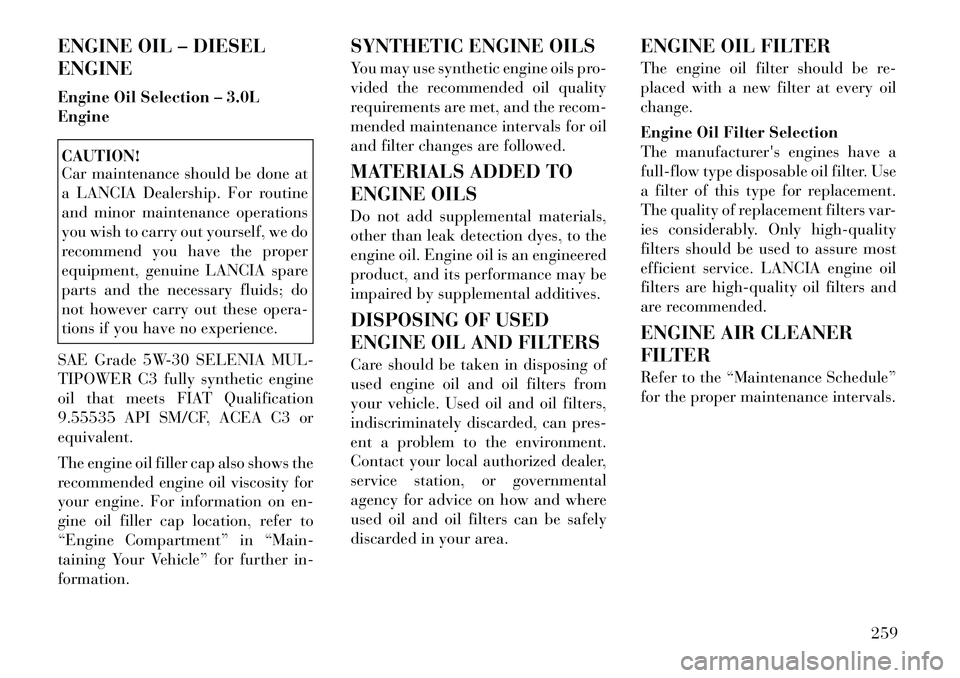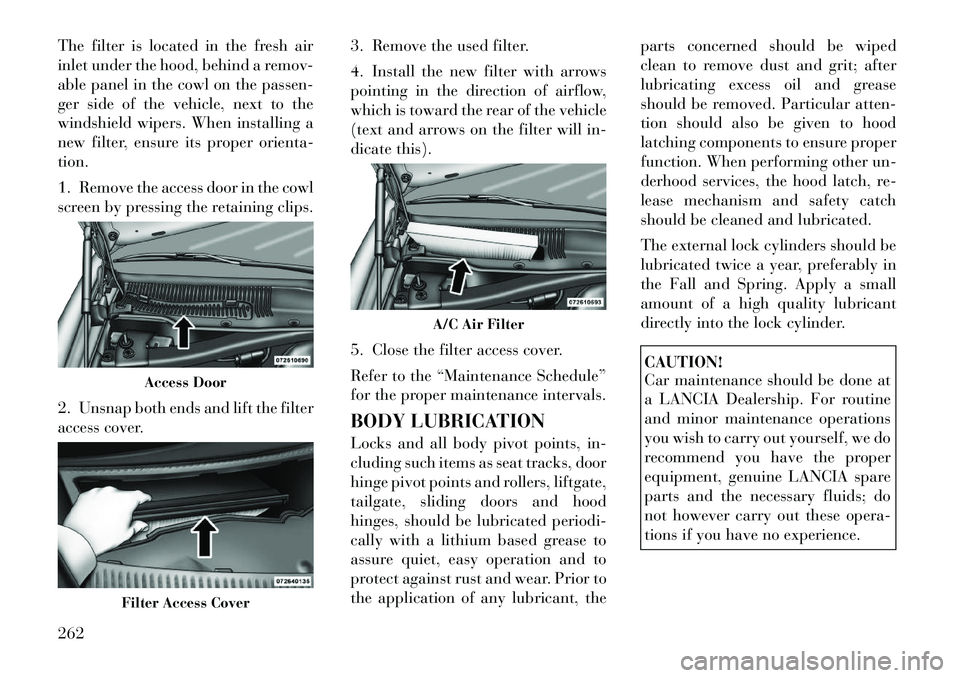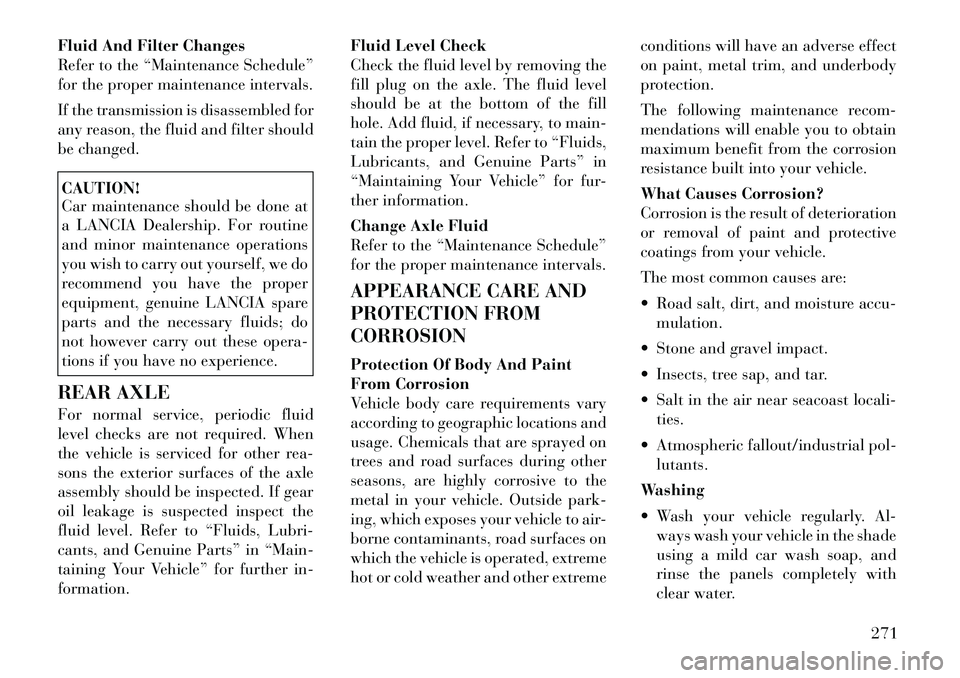maintenance schedule Lancia Thema 2012 Owner handbook (in English)
[x] Cancel search | Manufacturer: LANCIA, Model Year: 2012, Model line: Thema, Model: Lancia Thema 2012Pages: 316, PDF Size: 3.85 MB
Page 7 of 316

TABLE OF CONTENTS1INTRODUCTION . . . . . . . . . . . . . . . . . . . . . . . . . . . . . . . . . . . . . . . . . . . . . . . . . . . . . . . . . . . . . . . . . . 32THINGS TO KNOW BEFORE STARTING YOUR VEHICLE . . . . . . . . . . . . . . . . . . . . . . . . . . . . . . . . . . . 93UNDERSTANDING THE FEATURES OF YOUR VEHICLE . . . . . . . . . . . . . . . . . . . . . . . . . . . . . . . . . . 554UNDERSTANDING YOUR INSTRUMENT PANEL . . . . . . . . . . . . . . . . . . . . . . . . . . . . . . . . . . . . . . . 1495STARTING AND OPERATING . . . . . . . . . . . . . . . . . . . . . . . . . . . . . . . . . . . . . . . . . . . . . . . . . . . . . . 1876WHAT TO DO IN EMERGENCIES . . . . . . . . . . . . . . . . . . . . . . . . . . . . . . . . . . . . . . . . . . . . . . . . . . . 2397MAINTAINING YOUR VEHICLE . . . . . . . . . . . . . . . . . . . . . . . . . . . . . . . . . . . . . . . . . . . . . . . . . . . . 2538MAINTENANCE SCHEDULES . . . . . . . . . . . . . . . . . . . . . . . . . . . . . . . . . . . . . . . . . . . . . . . . . . . . . . 2899INDEX . . . . . . . . . . . . . . . . . . . . . . . . . . . . . . . . . . . . . . . . . . . . . . . . . . . . . . . . . . . . . . . . . . . . . . . 297
1
Page 225 of 316

CAUTION!(Continued)
Observe the tire chain manufac-
tur er's instructions on the method
of installation, operating speed,
and conditions for use. Always use
the lower suggested operating
speed of the chain manufacturer if
different from the speed r ecom-
mended by the manufacture.
NOTE:
In order to avoid damage to tires,
chains, and your vehicle do not
drive for a prolonged period on dry
pavement. Observe the tire chain
manufacturer's instructions on
method of installation, operating
speed, and conditions for usage.
Always use the lower suggested oper-
ating speed if both the chain manu-
facturer and vehicle manufacturer
suggest a maximum speed. This no-
tice applies to all chain traction de-
vices, including link and cable (ra-
dial) chains. TIRE ROTATION
RECOMMENDATIONS
Tires on the front and rear axles of
vehicles operate at different loads and
perform different steering, driving,
and braking functions. For these rea-
sons, they wear at unequal rates.
These effects can be reduced by timely
rotation of tires. The benefits of rota-
tion are especially worthwhile with ag-
gressive tread designs such as those on
all season type tires. Rotation will in-
crease tread life, help to maintain mud,
snow and wet traction levels, and con-
tribute to a smooth, quiet ride.Refer to the “Maintenance Schedule”
for the proper maintenance intervals.
The reasons for any rapid or unusual
wear should be corrected prior to ro-
tation being performed.
TIRE PRESSURE
MONITOR SYSTEM
(TPMS)
The Tire Pressure Monitor System
(TPMS) will warn the driver of a low
tire pressure based on the vehicle rec-
ommended cold placard pressure.The tire pressure will vary with tem-
perature by about 0.069 BAR for ev-
ery 6.5°C. This means that when the
outside temperature decreases, the
tire pressure will decrease. Tire pres-
sure should always be set based on
cold inflation tire pressure. This is
defined as the tire pressure after the
vehicle has not been driven for at least
three hours, or driven less than
1.6 km after a three hour period. The
cold tire inflation pressure must not
exceed the maximum inflation pres-
sure molded into the tire sidewall. Re-
fer to “Tires – General Information”
in “Starting and Operating” for infor-
mation on how to properly inflate the
vehicle’s tires. The tire pressure will
also increase as the vehicle is driven -
this is normal and there should be no
adjustment for this increased pres-
sure.
The TPMS will warn the driver of a
low tire pressure if the tire pressure
falls below the low-pressure warning
limit for any reason, including low
temperature effects and natural pres-
sure loss through the tire.
219
Page 241 of 316

Pin
Number Function Wire
Color
5 Right Rear
Position, SideMarker
Lights, and
Rear Registra- tion Plate
Illumination
Device.
b
Brown
6 Stoplights Red
7 Left Rear Position, SideMarker
Lights, and
Rear Registra-
tion Plate
Illumination Device.
b
Black
8 Reverse lights Red/ Black
9 Permanent
Power Supply(+12V) Brown/
White
10 Power Supply Controlled byIgnition
Switch
(+12V) Red
Pin
Number Function Wire
Color
11
a
Return for
Contact (Pin) 10 White
12 Reserve for Future Alloca-
tion Red/Blue
13
a
Return for
Contact (Pin) 9 White
Note: The allocation pin 12 has
been changed from “Coding for
coupled Trailer” to “Reserve for
Future Allocation.”
aThe three return circuits shall not
be connected electrically in the
trailer.bThe rear position registration
plate illumination device shall be
connected such that no light of the
device has a common connection
with both pins 5 and 7.
TOWING TIPS
Before setting out on a trip, practice
turning, stopping, and backing up the
trailer in an area located away from
heavy traffic. Automatic Transmission
The DRIVE range can be selected
when towing. However, if frequent
shifting occurs while in this range,
select a lower gear range using the
AutoStick® shift control (for
versions/markets, where provided).
NOTE:
Selecting a lower gear range while
operating the vehicle under heavy
operating conditions will improve
performance and extend transmis-
sion life by reducing excessive
shifting and heat buildup. This ac-
tion will also provide better engine
braking.
If you REGULARLY tow a trailer for
more than 45 minutes of continuous
operation, then change the automatic
transmission fluid and filter accord-
ing to the interval specified for “po-
lice, taxi, fleet, or frequent trailer tow-
ing.” Refer to the “Maintenance
Schedule” for the proper maintenance
intervals.
235
Page 263 of 316

ONBOARD DIAGNOSTIC
SYSTEM — OBD II
Your vehicle is equipped with a so-
phisticated onboard diagnostic sys-
tem called OBD II. This system moni-
tors the performance of the emissions,
engine, and automatic transmission
control systems. When these systems
are operating properly, your vehicle
will provide excellent performance
and fuel economy, as well as engine
emissions well within current govern-
ment regulations.
If any of these systems require service,
the OBD II system will turn on the
“Malfunction Indicator Light (MIL).”
It will also store diagnostic codes and
other information to assist your ser-
vice technician in making repairs. Al-
though your vehicle will usually be
drivable and not need towing, see
your authorized dealer for service as
soon as possible.
CAUTION!
Prolonged driving with the MILon could cause further damage to
the emissions control system. It
could also affect fuel economy
and driveability. The vehicle must
be serviced before any emissions
tests can be performed.
If the MIL is flashing while the
engine is running, severe catalytic
converter damage and power loss
will soon occur. Immediate service
is required.
REPLACEMENT PARTS
Use of genuine parts for normal/
scheduled maintenance and repairs is
highly recommended to ensure the de-
signed performance.
Damage or failures caused by the use
of parts which are not quality-
equivalent to genuine parts for main-
tenance and repairs will not be cov-
ered by the manufacturer’s warranty. MAINTENANCE
PROCEDURES
The pages that follow contain the
re-
quired maintenance services deter-
mined by the engineers who designed
your vehicle.
Besides those maintenance items
specified in the fixed maintenance
schedule, there are other components
which may require servicing or re-
placement in the future.
CAUTION!
Failure to properly maintain your vehicle or perform repairs and
service when necessary could re-
sult in more costly repairs, dam-
age to other components or nega-
tively impact vehicle
performance. Immediately have
potential malfunctions examined
by an authorized dealership or
qualified repair center.
(Continued)
257
Page 264 of 316

CAUTION!(Continued)
Car maintenance should be done
at a LANCIA Dealership. For rou-
tine and minor maintenance op-
erations you wish to carry out
yourself, we do recommend you
have the proper equipment, genu-
ine LANCIA spare parts and the
necessary fluids; do not however
carry out these operations if you
have no experience.
Your vehicle has been built with
improved fluids that protect the
performance and durability of
your vehicle and also allow ex-
tended maintenance intervals. Do
not use chemical flushes in these
components as the chemicals can
damage your engine, transmis-
sion, power steering or air condi-
tioning. Such damage is not cov-
ered by the New Vehicle Limited
Warranty. If a flush is needed be-
cause of component malfunction,
use only the specified fluid for the
flushing procedure. ENGINE OIL – GASOLINE
ENGINE
Checking Oil Level
To assure proper lubrication of your
vehicle's engine, the engine oil must
be maintained at the correct level.
The best time to check the engine oil
level is about five minutes after a fully
warmed up engine is shut off or before
starting the engine after it has sat
overnight.
Checking the oil while the vehicle is
on level ground will improve the
ac-
curacy of the oil level readings. Main-
tain the oil level in the SAFE level
range. Adding 0.95 Liter of oil when
the level is at the bottom of the SAFE
range will result in the level being at
the top of the SAFE range.
CAUTION!
Overfilling or underfilling the
crankcase will cause aeration or loss
of oil pressure. This could damage
your engine.
CAUTION!
Car maintenance should be done at
a LANCIA Dealership. For routine
and minor maintenance operations
you wish to carry out yourself, we do
recommend you have the proper
equipment, genuine LANCIA spare
parts and the necessary fluids; do
not however carry out these opera-
tions if you have no experience.
Change Engine Oil
Refer to the “Maintenance Schedule”
for the proper maintenance intervals.
Engine Oil Selection – 3.6L
Engine
SAE Grade 5W-30 SELENIA K
POWER fully synthetic engine oil that
meets FIAT Qualification 9.55535
API SN, ILSAC GF-5 or equivalent.
The engine oil filler cap also shows the
recommended engine oil viscosity for
your vehicle. For information on en-
gine oil filler cap location, refer to
“Engine Compartment” in “Main-
taining Your Vehicle” for further in-
formation.
258
Page 265 of 316

ENGINE OIL – DIESEL
ENGINE
Engine Oil Selection – 3.0L
EngineCAUTION!
Car maintenance should be done at
a LANCIA Dealership. For routine
and minor maintenance operations
you wish to carry out yourself, we do
recommend you have the proper
equipment, genuine LANCIA spare
parts and the necessary fluids; do
not however carry out these opera-
tions if you have no experience.
SAE Grade 5W-30 SELENIA MUL-
TIPOWER C3 fully synthetic engine
oil that meets FIAT Qualification
9.55535 API SM/CF, ACEA C3 or
equivalent.
The engine oil filler cap also shows the
recommended engine oil viscosity for
your engine. For information on en-
gine oil filler cap location, refer to
“Engine Compartment” in “Main-
taining Your Vehicle” for further in-
formation. SYNTHETIC ENGINE OILS
You may use synthetic engine oils pro-
vided the recommended oil quality
requirements are met, and the recom-
mended maintenance intervals for oil
and filter changes are followed.
MATERIALS ADDED TO
ENGINE OILS
Do not add supplemental materials,
other than leak detection dyes, to the
engine oil. Engine oil is an engineered
product, and its performance may be
impaired by supplemental additives.
DISPOSING OF USED
ENGINE OIL AND FILTERS
Care should be taken in disposing of
used engine oil and oil filters from
your vehicle. Used oil and oil filters,
indiscriminately discarded, can pres-
ent a problem to the environment.
Contact your local authorized dealer,
service station, or governmental
agency for advice on how and where
used oil and oil filters can be safely
discarded in your area.
ENGINE OIL FILTER
The engine oil filter should be re-
placed with a new filter at every oil
change.
Engine Oil Filter Selection
The manufactur
er's engines have a
full-flow type disposable oil filter. Use
a filter of this type for replacement.
The quality of replacement filters var-
ies considerably. Only high-quality
filters should be used to assure most
efficient service. LANCIA engine oil
filters are high-quality oil filters and
are recommended.
ENGINE AIR CLEANER
FILTER
Refer to the “Maintenance Schedule”
for the proper maintenance intervals.
259
Page 268 of 316

The filter is located in the fresh air
inlet under the hood, behind a remov-
able panel in the cowl on the passen-
ger side of the vehicle, next to the
windshield wipers. When installing a
new filter, ensure its proper orienta-
tion.
1. Remove the access door in the cowl
screen by pressing the retaining clips.
2. Unsnap both ends and lift the filter
access cover.3. Remove the used filter.
4. Install the new filter with arrows
pointing in the direction of airflow,
which is toward the rear of the vehicle
(text and arrows on the filter will in-
dicate this).
5. Close the filter access cover.
Refer to the “Maintenance Schedule”
for the proper maintenance intervals.
BODY LUBRICATION
Locks and all body pivot points, in-
cluding such items as seat tracks, door
hinge pivot points and rollers, liftgate,
tailgate, sliding doors and hood
hinges, should be lubricated periodi-
cally with a lithium based grease to
assure quiet, easy operation and to
protect against rust and wear. Prior to
the application of any lubricant, theparts concerned should be wiped
clean to remove dust and grit; after
lubricating excess oil and grease
should be removed. Particular atten-
tion should also be given to hood
latching components to ensure proper
function. When performing other un-
derhood services, the hood latch, re-
lease mechanism and safety catch
should be cleaned and lubricated.
The external lock cylinders should be
lubricated twice a year, preferably in
the Fall and Spring. Apply a small
amount of a high quality lubricant
directly into the lock cylinder.
CAUTION!
Car maintenance should be done at
a LANCIA Dealership. For routine
and minor maintenance operations
you wish to carry out yourself, we do
recommend you have the proper
equipment, genuine LANCIA spare
parts and the necessary fluids; do
not however carry out these opera-
tions if you have no experience.
Access Door
Filter Access Cover
A/C Air Filter
262
Page 272 of 316

flushed, and refilled with fresh cool-
ant. Check the front of the A/C con-
denser for any accumulation of bugs,
leaves, etc. If dirty, clean by gently
spraying water from a garden hose
vertically down the face of the con-
denser.
Check the coolant recovery bottle
tubing for brittle rubber, cracking,
tears, cuts, and tightness of the con-
nection at the bottle and radiator. In-
spect the entire system for leaks.
With the engine at normal operating
temperature (but not running), check
the cooling system pressure cap for
proper vacuum sealing by draining a
small amount of engine coolant (anti-
freeze) from the radiator drain cock.
If the cap is sealing properly, the en-
gine coolant (antifreeze) will begin to
drain from the coolant recovery
bottle. DO NOT REMOVE THE
COOLANT PRESSURE CAP WHEN
THE COOLING SYSTEM IS HOT.
Cooling System – Drain, Flush,
And Refill
If the engine coolant (antifreeze) is
dirty or contains a considerableamount of sediment, clean and flush
with a reliable cooling system cleaner.
Follow with a thorough rinsing to re-
move all deposits and chemicals.
Properly dispose of the old engine
coolant (antifreeze) solution.
Refer to the “Maintenance Schedule”
for the proper maintenance intervals.
Selection Of Coolant
Use only the manufactur
er's recom-
mended engine coolant (antifreeze).
Refer to “Fluids, Lubricants, and
Genuine Parts” in “Maintaining Your
Vehicle” for further information.
CAUTION!
Mixing of engine coolant (anti- freeze) other than specified engine
coolant (antifreeze), may result in
engine damage and may decrease
corrosion protection. If a non-
specified engine coolant (anti-
freeze) is introduced into the cool-
ing system in an emergency, it
should be replaced with the speci-
fied engine coolant (antifreeze) as
soon as possible.
(Continued)
CAUTION!(Continued)
Do not use water alone or alcohol-
based engine coolant (antifreeze)
products. Do not use additional
rust inhibitors or antirust prod-
ucts, as they may not be compat-
ible with the radiator engine cool-
ant (antifreeze) and may plug the
radiator.
This vehicle has not been de-
signed for use with propylene
glycol-based engine coolant (anti-
freeze). Use of propylene glycol-
based engine coolant (antifreeze)
is not recommended.
Adding Coolant
Your vehicle has been built with an
improved engine coolant (antifreeze)
that allows extended maintenance in-
tervals. This engine coolant (anti-
freeze) can be used up to five years or
168 000 km before replacement. To
prevent reducing this extended main-
tenance period, it is important that
you use the same engine coolant (an-
tifreeze) throughout the life of your
vehicle.
266
Page 274 of 316

When additional engine coolant (an-
tifreeze) is needed to maintain the
proper level, it should be added to the
coolant bottle. Do not overfill.
Points To Remember
NOTE:
When the vehicle is stopped after a
few kilometers of operation, you
may observe vapor coming from
the front of the engine compart-
ment. This is normally a result of
moisture from rain, or high hu-
midity accumulating on the radia-
tor and being vaporized when the
thermostat opens, allowing hot en-
gine coolant (antifreeze) to enter
the radiator.
If an examination of your engine com-
partment shows no evidence of radia-
tor or hose leaks, the vehicle may be
safely driven. The vapor will soon dis-
sipate.
Do not overfill the coolant recoverybottle.
Check engine coolant (antifreeze) freeze point in the radiator and in
the coolant recovery bottle. If en-
gine coolant (antifreeze) needs to be added, contents of coolant re-
covery bottle must also be pro-
tected against freezing.
If frequent engine coolant (anti- freeze) additions are required, or if
the level in the coolant recovery
bottle does not drop when the en-
gine cools, the cooling system
should be pressure tested for leaks.
Maintain engine coolant (anti- freeze) concentration at 50% en-
gine coolant (antifreeze) (mini-
mum) and distilled water for
proper corrosion protection of your
engine, which contains aluminum
components.
Make sure that the radiator and coolant recovery bottle overflow
hoses are not kinked or obstructed.
Keep the front of the radiator clean. If your vehicle is equipped with air
conditioning, keep the front of the
condenser clean.
Do not change the thermostat for Summer or Winter operation. If re-
placement is ever necessary, install
ONLY the correct type thermostat.
Other designs may result in unsat- isfactory engine coolant (anti-
freeze) performance, poor gas mile-
age, and increased emissions.
BRAKE SYSTEM
In order to assure brake system per-
formance, all brake system compo-
nents should be inspected periodi-
cally. Refer to the “Maintenance
Schedule” for the proper maintenance
intervals.
WARNING!
Riding the brakes can lead to brake
failure and possibly an accident.
Driving with your foot resting or rid-
ing on the brake pedal can result in
abnormally high brake tempera-
tures, excessive lining wear, and pos-
sible brake damage. You would not
have your full braking capacity in an
emergency.
268
Page 277 of 316

Fluid And Filter Changes
Refer to the “Maintenance Schedule”
for the proper maintenance intervals.
If the transmission is disassembled for
any reason, the fluid and filter should
be changed.CAUTION!
Car maintenance should be done at
a LANCIA Dealership. For routine
and minor maintenance operations
you wish to carry out yourself, we do
recommend you have the proper
equipment, genuine LANCIA spare
parts and the necessary fluids; do
not however carry out these opera-
tions if you have no experience.
REAR AXLE
For normal service, periodic fluid
level checks are not required. When
the vehicle is serviced for other rea-
sons the exterior surfaces of the axle
assembly should be inspected. If gear
oil leakage is suspected inspect the
fluid level. Refer to “Fluids, Lubri-
cants, and Genuine Parts” in “Main-
taining Your Vehicle” for further in-
formation. Fluid Level Check
Check the fluid level by removing the
fill plug on the axle. The fluid level
should be at the bottom of the fill
hole. Add fluid, if necessary, to main-
tain the proper level. Refer to “Fluids,
Lubricants, and Genuine Parts” in
“Maintaining Your Vehicle” for fur-
ther information.
Change Axle Fluid
Refer to the “Maintenance Schedule”
for the proper maintenance intervals.
APPEARANCE CARE AND
PROTECTION FROM
CORROSION
Protection Of Body And Paint
From Corrosion
Vehicle body care requirements vary
according to geographic locations and
usage. Chemicals that are sprayed on
trees and road surfaces during other
seasons, are highly corrosive to the
metal in your vehicle. Outside park-
ing, which exposes your vehicle to air-
borne contaminants, road surfaces on
which the vehicle is operated, extreme
hot or cold weather and other extreme
conditions will have an adverse effect
on paint, metal trim, and underbody
protection.
The following maintenance recom-
mendations will enable you to obtain
maximum benefit from the corrosion
resistance built into your vehicle.
What Causes Corrosion?
Corrosion is the result of deterioration
or removal of paint and protective
coatings from your vehicle.
The most common causes are:
Road salt, dirt, and moisture accu-
mulation.
Stone and gravel impact.
Insects, tree sap, and tar.
Salt in the air near seacoast locali- ties.
Atmospheric fallout/industrial pol- lutants.
Washing
Wash your vehicle regularly. Al- ways wash your vehicle in the shade
using a mild car wash soap, and
rinse the panels completely with
clear water.
271